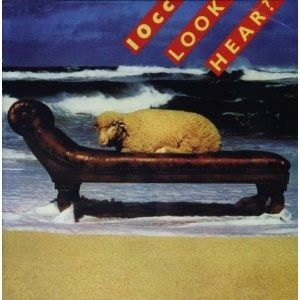The Wiseacre Duos: 10cc, Part VI
It's a sad thing, watching a musical unit trudge on long past their expiration date. By 1980, 10cc were disorganized and weary. Former members Godley and Creme had been off making their own records, oddities like L, Freeze Frame, and in 1981, Ismism (retitled Snack Attack for U.S., complete with hilariously silly cover) and soon to embark on a new frontier, music videos. Graham Gouldman and Eric Stewart continued on but their music was increasingly dreary and strangely, paradoxically weighed down by pop sensibilities. The evidence was there on Bloody Tourists. By Look Hear? (Originally Are You Normal) three years later, aside from the not bad "One Two Five", the songbook became marginal, devoid of interest.
There were set-backs. Stewart suffered an accident that damaged his left ear, rendering him unable to record or produce for some time. 10cc decided to go the session musician route (ala Steely Dan) for their early '80s efforts, Ten out of 10 and Windows in the Jungle, the latter featuring "Aja" drummer Steve Gadd. Among sides of forgettable songs like "L.A. Inflatable" was a late, minor gem from Ten called "Feel the Love", a really catchy number with a video directed by Godley & Creme. How that occurred must make for interesting reading.
Among G & C's other visual works were Duran Duran's "Girls on Film", quite the controversial clip with its frolicking fashion models on runways and in kiddie pools. It was banned by MTV for its sexuality and toplessness before a more PG cut was delivered. The duo would go on to demonstrate their prodigious talents for the medium with several videos for, among many others, The Police, including "Synchronicity II", a MAD MAX like set piece, Herbie Hancock's "Rockit", Wang Chung's "Everybody Have Fun Tonight", Yes' "Leave It", and a few for Frankie Goes to Hollywood. All were innovative and crazily imaginative. Godley & Creme's own "Englishman in New York" was an early effort, a marionette extravaganza that paved the way for "Rockit". In 1985, their "Cry" utilized analog cross-fading, a morphing-like technique blending actors' faces into each other. Quite revolutionary for the time. The duo picked up an MTV video award for their work.
Meanwhile, Gouldman and Stewart began to grow apart, producing others' projects and collaborating less on 10cc. A final tour (for awhile) proceeded in 1983. American artist Andrew Gold was recruited in efforts to freshen the sound. But 10cc's time had long passed. Each new album sounded more tired than the previous. They are worth a listen for curiosity's sake, but not worth the $$ it would require for vinyl or a disc. Search YouTube instead.
For the next, and final entry for 10cc's series, we'll cover the band's reunions, switched allegiances, resignations, and desperate attempts to soldier on.
There were set-backs. Stewart suffered an accident that damaged his left ear, rendering him unable to record or produce for some time. 10cc decided to go the session musician route (ala Steely Dan) for their early '80s efforts, Ten out of 10 and Windows in the Jungle, the latter featuring "Aja" drummer Steve Gadd. Among sides of forgettable songs like "L.A. Inflatable" was a late, minor gem from Ten called "Feel the Love", a really catchy number with a video directed by Godley & Creme. How that occurred must make for interesting reading.
Among G & C's other visual works were Duran Duran's "Girls on Film", quite the controversial clip with its frolicking fashion models on runways and in kiddie pools. It was banned by MTV for its sexuality and toplessness before a more PG cut was delivered. The duo would go on to demonstrate their prodigious talents for the medium with several videos for, among many others, The Police, including "Synchronicity II", a MAD MAX like set piece, Herbie Hancock's "Rockit", Wang Chung's "Everybody Have Fun Tonight", Yes' "Leave It", and a few for Frankie Goes to Hollywood. All were innovative and crazily imaginative. Godley & Creme's own "Englishman in New York" was an early effort, a marionette extravaganza that paved the way for "Rockit". In 1985, their "Cry" utilized analog cross-fading, a morphing-like technique blending actors' faces into each other. Quite revolutionary for the time. The duo picked up an MTV video award for their work.
Meanwhile, Gouldman and Stewart began to grow apart, producing others' projects and collaborating less on 10cc. A final tour (for awhile) proceeded in 1983. American artist Andrew Gold was recruited in efforts to freshen the sound. But 10cc's time had long passed. Each new album sounded more tired than the previous. They are worth a listen for curiosity's sake, but not worth the $$ it would require for vinyl or a disc. Search YouTube instead.
For the next, and final entry for 10cc's series, we'll cover the band's reunions, switched allegiances, resignations, and desperate attempts to soldier on.



Comments